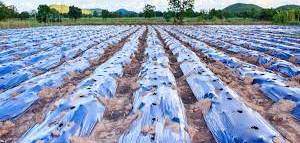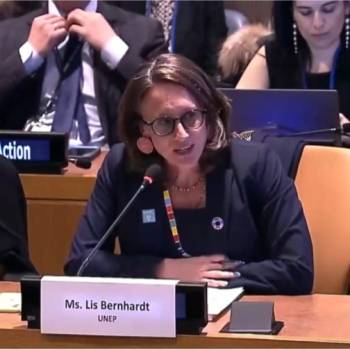
We've all seen some sobering imagery of dead birds and turtles suffocated by the plastic that increasingly invades marine ecosystems.
In many parts of the world, this type of plastic pollution has made headlines.
Yet there is a similar environmental scourge that attracts far less attention, but is potentially just as harmful, experts say: agricultural plastic pollution. UN Program of recent research for the Environment (UNEP) and the United Nations Food and Agriculture Organization (FAO) show that agricultural soils can receive larger quantities of that microplastics the oceans.
The result of the slow deterioration of materials and tools, this plastic seeps into soils around the world, reducing its quality and often entering the food chain.
Experts are sounding the alarm on what they call an invisible threat to global food systems.
"Our accounting systems attribute no value to soil health, so that incentives to maintain healthy soil are low," said Mahesh Pradhan, Coordinator Global Partnership on Nutrient Management Of UNEP. "The plastic products in the farms are really part of the toxic trail from economic growth. "
7 ways to tackle the scourge of single-use plastics
Plastics in soils are a global problem that usually goes hand in hand with intensive agriculture. According to experts, they are present everywhere, from Asia to North America to Africa. Stemming the tide will be crucial in the years to come. Researchers estimate that more than 8.3 billion tons of plastic have been produced since the early 1950s and that the global volume of plastic waste continues to grow.
According to the World Evaluation of soil pollution , while the world population is expected to increase to 2 billion by 2050, reducing plastic pollution in soils is essential for progress towards the realization of United Nations Sustainable Development Goals (SDGs).
The report, published by UNEP and FAO, shows that global food security is compromised by soil pollution. If this problem is not addressed, it will continue to hamper the achievement of goals related to the eradication of poverty (SDG 1), famine (SDG 2) and the provision of safe drinking water (SDG 6). , among others.
Origin story
Decaying greenhouses are a major source of plastic pollution in soils
Much of the plastic that ends up in the soil is part of the single-use plastics family, Pradhan says. Common sources include plastic mulch films, which are used around plants to keep the soil moist, and plastic-encapsulated, slow-release fertilizers, he says. Other plastic products include films for greenhouses and silage, shading and protective netting, and drip irrigation, says Lev Neretin, of the Office of Climate Change, Biodiversity and the FAO environment.
Many farmers are increasingly dependent on agricultural plastics, which Neretin says prolong growing seasons, reduce pesticide consumption, protect plants from inclement weather, improve water efficiency and can increase yields up to 60%.
Many of these plastics break down into particles smaller than 5mm, known as microplastics, before decaying further into nanoparticles, smaller than 0.1 micrometers. These can then seep into the soil and groundwater systems.
"But the problem is not insoluble," says Kristina Thygesen, senior expert at GRID Arendal who works with UNEP on research on plastics in agriculture. “The first step in solving this problem is to start growing more crops that are better suited to the climate,” she added.
Health impacts
In 2018, German researchers have estimated that about 400 million tons of plastic produced in the world each year, a third of them end up as plastic waste in the soil or fresh water.
How the soil interacts with plastic depends on several factors, including humidity, acidity, ultraviolet light, and the size and type of plastic.
"The problem is, we don't know how much degradation of these products causes long-term damage to agricultural soils," Pradhan explains. “We need to develop standardized methods for detecting microplastics in soil to better understand how long they stay there and how they change over time. "
Some studies suggest that degraded plastics can build up in the food chain. Although more research is needed regarding the health impacts, Neretin says studies have identified microplastics in human organs, most recently in the brain.
“The precautionary principle dictates that much more research is needed on this topic,” he said, adding that the world must work to remove microplastics from the food chain.
Next steps
Thygesen says innovation will be the key to ending agriculture's dependence on plastic.
"At present, a farmer can use plastic to control weeds, but perhaps a little machine could be developed to recognize and eliminate weeds," she said. “We live in a high-tech world, and we can find solutions if we really want to. We need to develop a new generation of agricultural technology. "
Pradhan says the entire agricultural sector needs to become more efficient and reuse plastics.
This happens in many places, says Neretin. Some 60 countries have developed so-called extended producer responsibility regimes for the management of empty pesticide containers, which impose on manufacturers the responsibility of treating or disposing of their products at the end of their life cycle. life. Some programs also collect and recycle a wider range of agricultural plastics.
Some manufacturers have also turned to innovative materials, such as biodegradable plastic, which they believe can be safely broken down by microbes and turned into biomass or water. Ultimately, however, experts say this is a problem that will not be addressed by a single group.
Farmers also need training on plastic management and disposal and equitable access to sustainable alternatives, Neretin explains. Regulators also need to establish clear guidelines for the use and disposal of agricultural plastics. Plastics manufacturers must innovate and provide circular solutions, and "science must study pollution pathways in soil and food chains to determine the effects of plastic pollution ," he said.
About World Soil Day
The World Soil Day is held annually on December 5th to draw attention to the importance of healthy soils and advocate for sustainable land resource management.
The United Nations Environment Program (UNEP), the United Nations Food and Agriculture Organization (FAO) GRID Arendal Study jointly the issue of agricultural plastics.
Posted on 2021-12-21 16:19








Comments